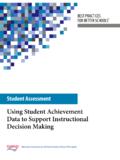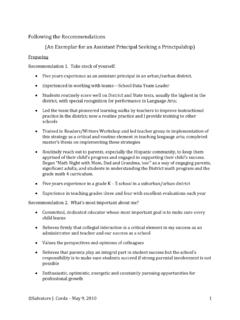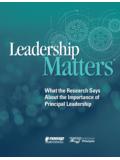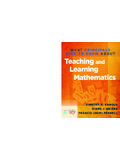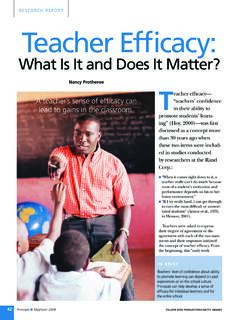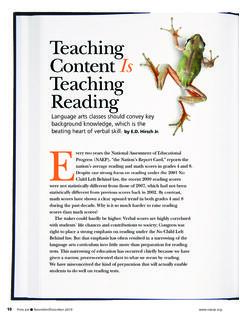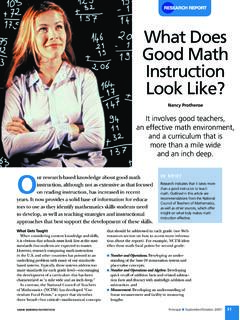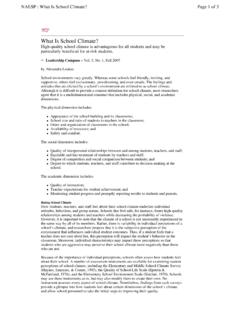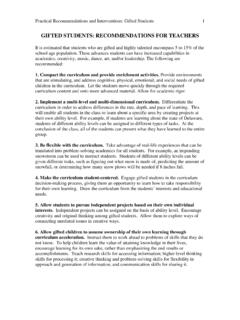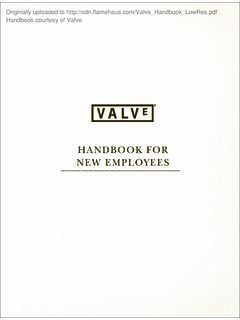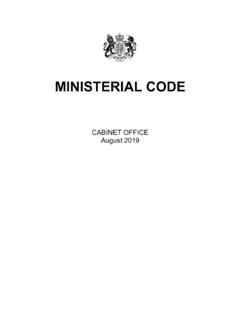Transcription of THE GIFTED AND TALENTED CHILD Best Practices
1 N May/June 2009 THE GIFTED AND TALENTED CHILDBest Practices9 Principal n May/June 2009 MArTIN BArrAuD/GETTy IMAGEsNo single test can capture a GIFTED student s dynamic K. JohnsenParents often go to principals to ask for help in supporting their GIFTED children. They may request acceleration for their CHILD in mathematics, a spe-cialized curriculum or course, extracurricular activities, a pullout program, or even a different teacher. Since misconceptions about identifying GIFTED students are prevalent, it s important that principals have information that will help parents make good decisions. for Identifying GIFTED StudentsBest n May/June 2009 Who Are GIFTED and TALENTED Children?Children who are GIFTED and tal-ented exhibit a wide range of charac-teristics. Some may excel in academic subjects, performing well above grade level in specific areas, such as math or reading.
2 Others may be more interested in the arts, playing musical instruments, or using various media to demonstrate their talents. Still others may show leadership abilities by work-ing with their peers to achieve specific goals. This variety is reflected in the federal definition of GIFTED and talent-ed students, as stated in the Improv-ing America s Schools Act of 1994:The term GIFTED and TALENTED when used in respect to students, children, or youth means students, children, or youth who give evidence of high perfor-mance capability in areas such as intel-lectual, creative, artistic, or leadership capacity, or in specific academic fields, and who require services or activities not ordinarily provided by the school in order to fully develop such capabilities. Since the federal government does not mandate GIFTED education, states are free to develop their own definitions.
3 Most choose to incorporate diversity, with 30 states recognizing intellectually GIFTED ; 29 recognizing academically gift-ed; 19 recognizing creatively GIFTED ; 13 recognizing leadership; and 20 recog-nizing giftedness in performing/visual arts (NAGC & CSDPG, 2005). Some states even specifically address special populations, such as English-language learners (Arizona and Florida), GIFTED students with disabilities (Arizona and Kentucky), culturally diverse students (California and Florida), rural students (Vermont), and highly GIFTED students (California). Because of the diversity among students with gifts and talents, most professionals in GIFTED education have moved away from a psychometrically derived definition ( , a high score on an intelligence test) and toward broader conceptual models. These models incorporate a multiplicity of factors that influence a GIFTED and TALENTED CHILD s development and ultimate display of high-quality per-formances and products.
4 For exam-ple, Tannenbaum (2003) identified five influential factors: n General ability ( , IQ);n Special ability ( , aptitude in a specific area);n Non-intellective facilitators ( , dedication to a chosen field, strong self-concept, willingness to sacrifice, mental health);n Environmental influences ( , parents, classroom, peers, culture, social class); andn Chance ( , accidental, general exploratory, sagacity, personalized action). In his model, Gagn (1995, 1999) not Headband for Adjustable ComfortAmbient Noise-reducing Earcups Diminish DistractionIndividual Volume ControlNoise-canceling MicrophoneShatter-resistant ABS Plastic for Safety and Durability The Headset for Adapted Literacy & Language Programs Comes from Califone ..Of Course!Califone Deluxe Multimedia Stereo Headsets help students focus and interact successfully with instructional and assessment content.
5 Priced affordably and engineered for the rigors of daily use, Califone Headsets are the clear choice for district-wide technology and multimedia programs in the classroom and library. shown with a choice of or USB plugThe Sound of EducationSM Booth 818 at n May/June 2009only identified a variety of factors but also discriminated between gifts and tal-ents. According to him, gifts are natural abilities that must be developed into talents, which emerge through the sys-tematic learning, training, and practic-ing of those skills that are characteristic to a particular field. This development may be facilitated or hindered by two general categories of factors: Intrapersonal catalysts are influenced by genetic background and include physical ( , health, physical appear-ance) and psychological ( , motiva-tion, personality, volition) factors.
6 Environmental catalysts include sur-roundings ( , physical, social, cul-tural); persons ( , parents, teachers, mentors, siblings, peers); undertakings ( , programs for GIFTED and TALENTED students, extracurricular activities); and events ( , death of a parent, major ill-ness, winning an award). Master InstructionalStrategies Flip ChartThis flip chart provides behavioral interventions for building positive behavior support; accommodations that provide all students access to the curriculum; suggestions for how to differentiate learning; learning style strategies; instructional strategies that reflect research findings; and Bloom s Taxonomy to promote critical WheelThe Accommodations WheelTM is a tool to assist teachers, parents, and specialists as they collaboratively make decisions to help students be successful in school. Accommodations provide students equal access to the curriculum.
7 The selection of appropriate accommodations allows learners to actively participate with other students in the general education classroom and in school-wide Strategies GuideThe Intervention Strategies GuideTM is a tool to help educators provide research-based academic andbehavioral intervention strategies to identified Strategies GuideEffective teaching requires considerable skill in managing the multitude of tasks and situations that occur daily in a Behavior GuideTM is an easy-to-use resource that provides K-8 educators techniques and strategies for creating the disciplined environment needed for effective ; udentsons for howyle hat reflectxonomy to tool toalistsons to ction of ws other erable skilland ther onsMust HaveSTRATEGIESfor the classroom!Master InstructionalStrategiesFlipChartMust HaveSTRATEGIESfor the classroom! 800-585-5258 Fax: n May/June 2009 The Identification Process In developing a method for identify-ing GIFTED and TALENTED students, there are important issues to be considered (Johnsen, 2008): GIFTED students will exhibit their talents not only in a domain but also within a spe-cific area of interest.
8 For example, Zack, a fourth grader, performed similarly to his age peers on classroom science activ-ities, but was well beyond grade level in his theoretical understanding of the shape of the universe and black holes, which emerged incidentally during an opportunity for independent study. Giftedness is a dynamic concept. A single test score may not capture how a CHILD s gifts might be developed into talents, particularly for children who have limited opportunities for out-of-school enrichment activities (Johnsen, Robins, Witte, & Feuerbacher, 2003). Any iden-tification method should therefore con-sider ways of providing opportunities for students to exhibit their gifts and collect samples of the students work over a period of time. Gifts and talents are exhibited by chil-dren who have disabilities, or who come from different ethnic, cultural, and eco-nomic backgrounds.
9 It is estimated that black, Hispanic, and Native American students are underrepresented by about 50 percent in GIFTED education programs (Ford, 1996). To improve identification of special populations of GIFTED students, professionals need to examine local and state definitions so that a wider range of characteristics are considered. Teachers also need to be trained to observe characteristics that may be manifested in different ways by different cultural groups and by children with disabilities (Fern ndez, Gay, Lucky, & Gavil n, 1998; Johnsen & Ryser, 1994; Whitmore, 1981). Early identification is important to the development of gifts into talents. Identify-ing students gifts early is particularly important for children who come from economically disadvantaged back-grounds. When provided with challeng-ing learning activities that nurture their gifts, these children perform at a much n May/June 200913higher level than children who are provided a skill-based curriculum that focuses on their weaknesses (Borland, Schnur, & Wright, 2000; Johnsen & Ryser, 1994).
10 Best Practices Given these four issues, best Practices in identification methods incorporate:Multiple assessments, because no one test can possibly sample all of the behaviors that a GIFTED student might demonstrate. Consequently, informa-tion needs to be gathered from qualita-tive assessments ( , portfolios, check-lists); from quantitative assessments; from different sources ( , teacher, parent, student, peer); and in different contexts ( , school, home, extracur-ricular activities). A pre-referral process, where teachers provide challenging and differentiated opportunities in their classrooms and observe their students responses. Parent involvement in developing knowledge about GIFTED students so that they understand the purpose of a GIFTED program and can become observers and developers of their own children s gifts. Identification Phases Most often, states and school districts organize their GIFTED identification procedures into three phases (Johnsen, 2004), with decisions made at each phase to determine if the students will progress to the next.
